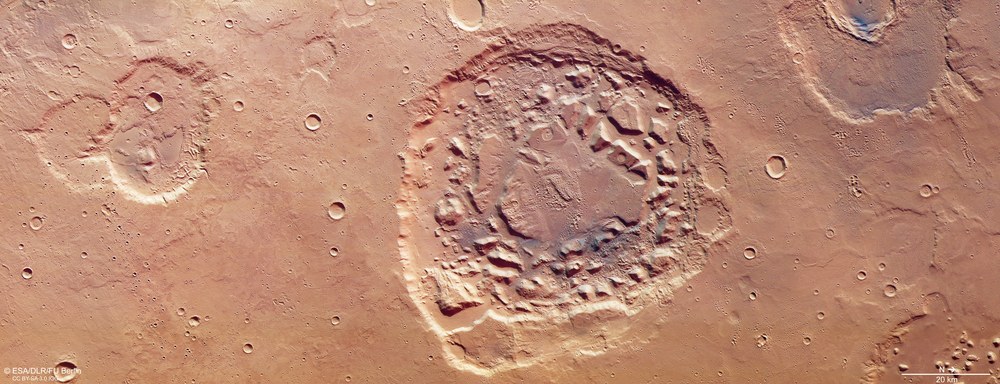Ismenia Patera – impact crater or supervolcano?



- The crater Ismenia Patera is 75 kilometers wide and lies at the transition between the southern highlands and the northern lowlands on Mars
- Future missions investigating the Martian subsoil with new measurement methods, such as NASA's Insight mission, can provide more insight here
- Focus: Space, planetary research
Images from the High Resolution Stereo Camera (HRSC) operated by the German Aerospace Center (Deutsches Zentrum für Luft- und Raumfahrt; DLR) on board ESA's Mars Express spacecraft show the collapsed depression Ismenia Patera. There are two hypotheses regarding the formation of this geological structure – it is either an impact crater or the caldera of a Martian supervolcano.
Ismenia Patera (Latin: patera – shallow bowl) is located in the Arabia Terra region, at the transition between the Martian southern highlands and northern lowlands. Inside the 75-kilometre-wide crater, hills and several hundred-metre-high mesas are arranged in a circle around the centre (Images 1, 4 and 5). On closer inspection, small gullies running into the crater are visible in some places on the rim of Ismenia Patera, which have been formed by water or ice flowing into the crater (Image 2). The floor of the crater is covered by deposits, the surfaces of which display traces of previous ice flow. These patterns were probably produced by rock glaciers – ice flows whose surfaces transport large quantities of boulders and debris. Similar phenomena are present on Earth in the Alpine and Polar regions, where glacial ice is completely covered by debris that has slid onto the ice from the surrounding mountain slopes. This ice-debris mass moves slowly downslope, leaving behind such flow structures.
Conspicuous groups of small impact craters, for example in the centre of Ismenia Patera, were probably caused by another meteorite impact in the immediate vicinity, which ejected large boulders towards the centre of the crater, producing small craters.
There are various opinions regarding the formation of the crater. According to one hypothesis, it was formed by a meteorite impact and subsequently filled with material deposits and, at times, with ice. Eventually, the crater surface collapsed as the underground ice melted and the water evaporated, leaving behind a rugged, hilly landscape. Another hypothesis suggests that Ismenia Patera is a volcanic caldera – a volcanic crater created by the emptying of the magma chamber following a large eruption. Volcanoes that produce a large amount of material during a single eruption are called supervolcanoes. Apart from Ismenia Patera, there are two other supervolcano candidates in Arabia Terra, namely Siloe Patera and Eden Patera. On Earth, volcanic structures such as the Phlegraean Fields near Naples, the Yellowstone area and Lake Taupo in New Zealand are considered to be supervolcanoes. On Mars, however, volcanic eruptions are no longer expected.
The theory of supervolcanoes in the ancient volcanic province in Arabia Terra is still a controversial topic for Mars researchers. In favour of the volcanic crater theory is the fact that the 'paterae' are irregularly-shaped collapse features with low topographic relief – partly without ejecta deposits elevated crater rim – which would be typical of impact craters. On the other hand, such an irregular shape may also be created by superimposed and subsequently altered impact craters. Future measurement methods for examining the Martian subsoil, to provide evidence for the existence of magma chambers below the paterae, for example, could shed light on this matter. These include seismic experiments, such as those on board NASA's InSight lander scheduled for launch on 5 May 2018, as well as orbiting radar experiments.
Image processing
The image data was acquired by HRSC on 1 January 2018, during Mars Express orbit 17,723. The image resolution is 17 metres per pixel. The centre of the imaged area is at approximately two degrees east and 39 degrees north. The colour overhead view (Image 1) was created using data acquired by the nadir channel, which is directed perpendicular to the Martian surface, and the colour channels. The oblique perspective view (Image 2) was computed from data acquired by the stereo channels of HRSC. The anaglyph (Figure 4), which creates a three-dimensional impression of the landscape when viewed through red-blue or red-green glasses, was derived from data supplied by the nadir channel and one stereo channel. The colour-coded topographic view (Image 5) is based on a digital terrain model (DTM) of the region, from which the topography of the landscape can be derived. The reference body for the HRSC DTM is an equipotential surface for Mars (areoid). Staff at the Department of Planetary Science and Remote Sensing at the Free University of Berlin produced the image products shown here. The systematic processing of the data takes place at the DLR Institute of Planetary Research in Berlin-Adlershof.
The HRSC experiment
The High Resolution Stereo Camera was developed at the German Aerospace Center (Deutsches Zentrum für Luft- und Raumfahrt; DLR) and built in collaboration with partners in industry (EADS Astrium, Lewicki Microelectronic GmbH and Jena-Optronik GmbH). The science team, which is headed by principal investigator (PI) Ralf Jaumann, consists of over 51 co-investigators from 35 institutions and 11 countries. The camera is operated by the DLR Institute of Planetary Research in Berlin-Adlershof.
